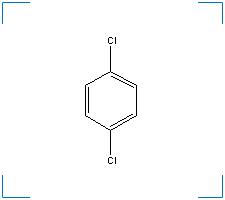Data Collection
Para-Dichlorobenzene
CAS Number: 106-46-7
Basic Information
 Synonym(s): 1,4-Dichlorobenzene; PARA; para-Dichlorobenzene; p-dichlorobenzol; p-chlorophenyl chloride; Paracide; Paradow; Paramoth; paranuggets; Para-zene; Dichlorobenzene, 1,4- ; Dichlorocide; dichloricide; DCB; Evola; globol; PDB; PDCB; persia-perazol; santochlor
Synonym(s): 1,4-Dichlorobenzene; PARA; para-Dichlorobenzene; p-dichlorobenzol; p-chlorophenyl chloride; Paracide; Paradow; Paramoth; paranuggets; Para-zene; Dichlorobenzene, 1,4- ; Dichlorocide; dichloricide; DCB; Evola; globol; PDB; PDCB; persia-perazol; santochlor
Formula: C6H4Cl2
Molecular Weight: 147.01
Boiling Point (°C): 173.4
Melting Point (°C): 53.1
Contaminant Type: Para-Dichlorobenzene is an insecticide.
Notes: Colorless solid with a mothball-like odor
Solubility (in water)
- Solubility:
49
mg/l
ak
Temperature (°C): 22
- Solubility:
79
mg/l
ak
Temperature (°C): 25
Half-Life (in soil unless otherwise noted)
- t1/2:
1-6
months
f
Environment: Scientific judgement based upon unacclimated aerobic screening test data and aerobic soil grad sample data
Toxicity Effects
- Organism Type:
Crustaceans
ak
Common Name: Daphnia
Scientific Name: Daphnia magna
Toxicity: 0.5 mg/l
Test: 21d NOEC
- Organism Type:
Crustaceans
ak
Common Name: Daphnia
Scientific Name: Daphnia magna
Toxicity: 1.5 mg/l
Test: 24h EC0
- Organism Type:
Crustaceans
ak
Common Name: Daphnia
Scientific Name: Daphnia magna
Toxicity: 3.2 mg/l
Test: 24h EC50
- Organism Type:
Crustaceans
ak
Common Name: Daphnia
Scientific Name: Daphnia magna
Toxicity: 0.7 mg/l
Test: 48h EC50
- Organism Type:
Crustaceans
ak
Common Name: Daphnia
Scientific Name: Daphnia magna
Toxicity: 2.2 mg/l
Test: 48h LC50
- Organism Type:
Crustaceans
ak
Common Name: Daggerblade grass shrimp
Scientific Name: Palaemonetes pugio
Toxicity: 129 mg/l
Test: 48h LC50
- Organism Type:
Crustaceans
ak
Common Name: Daggerblade grass shrimp
Scientific Name: Palaemonetes pugio
Toxicity: 69 mg/l
Test: 96h LC50
- Organism Type:
Fish
ak
Common Name: Zebra danio
Scientific Name: Brachydanio rerio
Toxicity: 0.44 mg/l
Test: 14d NOEC
- Organism Type:
Fish
ak
Common Name: Zebra danio
Scientific Name: Brachydanio rerio
Toxicity: 4.8 mg/l
Test: 48h LC50
- Organism Type:
Fish
ak
Common Name: Zebra danio
Scientific Name: Brachydanio rerio
Toxicity: 2.1 mg/l
Test: 96h LC50
- Organism Type:
Fish
ak
Common Name: Sheepshead minnow
Scientific Name: Cyprinodon variegatus
Toxicity: 7.4 mg/l
Test: 96h LC50
- Organism Type:
Fish
ak
Common Name: Sheepshead minnow
Scientific Name: Cyprinodon variegatus
Toxicity: 5.6 mg/l
Test: 96h NOEC
- Organism Type:
Fish
ak
Common Name: Orfe
Scientific Name: Idus idus, or Leuciscus idus
Toxicity: 50 mg/l
Test: 72h LC0
- Organism Type:
Fish
ak
Common Name: Flagfish
Scientific Name: Jordanella floridae
Life Stage: Fry
Toxicity: >0.35 mg/l
Test: 96h LC50
Formulation: fry survival
- Organism Type:
Fish
ak
Common Name: Flagfish
Scientific Name: Jordanella floridae
Life Stage: Fry
Toxicity: >0.35 mg/l
Test: 96h LC50
Formulation: fry growth
- Organism Type:
Fish
ak
Common Name: Flagfish
Scientific Name: Jordanella floridae
Life Stage: Egg
Toxicity: >0.84 mg/l
Test: 96h LC50
Formulation: egg hatchability
- Organism Type:
Fish
ak
Common Name: Flagfish
Scientific Name: Jordanella floridae
Life Stage: Larval
Toxicity: 0.26 mg/l
Test: 96h LC50
Formulation: larval survival
- Organism Type:
Fish
ak
Common Name: Fathead minnow
Scientific Name: Pimephales promelas
Toxicity: 35 mg/l
Test: 24h LC50
- Organism Type:
Fish
ak
Common Name: Fathead minnow
Scientific Name: Pimephales promelas
Toxicity: 34 mg/l
Test: 48h LC50
- Organism Type:
Fish
ak
Common Name: Fathead minnow
Scientific Name: Pimephales promelas
Toxicity: 34 mg/l
Test: 96h LC50
- Organism Type:
Fish
ak
Common Name: Guppy
Scientific Name: Poecilia reticulata
Toxicity: 4 mg/l
Test: 14d LC50
Soil Organic Carbon/Water Partition Coefficients
- Koc:
3.22
ak
Formulation: log
- Koc:
850
ak
Formulation: "for Fullerton soil, 0.06% organic carbon"
- Koc:
665
ak
Formulation: "for Apison soil, 0.11% organic carbon"
- Koc:
280
ak
Formulation: for Dormont soil 1.2% organic carbon
Octanol-Water Partition Coefficients
- Log Kow:
3.39
ak
Formulation: at 20C
Work Cited
|
f
|
Howard, P. H., R. S. Boethling, W. F. Jarvis, W. M. Meylan, and E. M. Michalenko. 1991. Handbook of Environmental Degradation Rates. Lewis Publishers., Chelsea, MI.
|
|
ak
|
Verschueren, K. 2001. Handbook of Environmental Data on Organic Chemicals, 4th edition. John Wiley & Sons, Inc., New York.
|